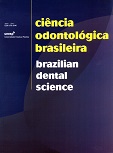Resistência ao cisalhamento da união de um cimento resinoso a um cerômero submetido a diferentes tratamentos de superfície
DOI:
https://doi.org/10.14295/bds.2009.v12i2.345Resumo
Este estudo avaliou a influência de diferentes tratamentos de superfície na resistência de união de um cimento resinoso (Rely X – 3M ESPE) a um cerômero (Cristobal – Microdont). Quarenta discos da resina foram confeccionados (3,0 x 4,0 mm), fixados em cilindros plásticos e divididos em cinco grupos, de acordo com o tratamento de superfície: 1 – condicionamento com ácido fosfórico 37% por 15 segundos (controle); 2 – jateamento com óxido de alumínio 50 μm por 15 segundos; 3 - jateamento com óxido de alumínio mais aplicação de silano por 1 minuto; 4 - jateamento com óxido de alumínio, ácido fosfórico 37% e silano; 5 - jateamento com sílica 30 μm (Cojet - 3M Dental) e silano. Após, foi aplicado sistema adesivo (Single Bond 2 – 3M) e o cimento resinoso inserido na superfície do compósito através de uma matriz circular de teflon (3,0 x 3,0 mm). O cimento foi fotoativado (Optilight / Gnatus - 400 mW/cm2) por 40 segundos. Após armazenamento em água destilada (± 37ºC / 24 horas), foi realizado ensaio de cisalhamento na máquina de ensaio universal (EMIC DL 2000, velocidade: 1 mm/min). Os valores obtidos foram: Grupo 1 – 7,29 MPa; Grupo 2 – 22,13 MPa; Grupo 3 – 20,43 MPa; Grupo 4 – 22,93 MPa; Grupo 5 – 23,58 MPa. Os dados foram submetidos à análise de variância e ao teste de Tukey (5%). Apenas o grupo controle apresentou diferença estatisticamente significante dos demais. O jateamento com óxido de alumínio ou sílica resultou no aumento da resistência de união entre cimento resinoso e cerômero.
Downloads
Downloads
Publicado
Como Citar
Edição
Seção
Licença
TRANSFERÊNCIA DE DIREITOS AUTORAIS E DECLARAÇÃO DE RESPONSABILIDADE
Toda a propriedade de direitos autorais do artigo "____________________________________________________________________" é transferido do autor(es) para a CIÊNCIA ODONTOLÓGICA BRASILEIRA, no caso do trabalho ser publicado. O artigo não foi publicado em outro lugar e não foi submetido simultaneamente para publicação em outra revista.
Vimos por meio deste, atestar que trabalho é original e não apresenta dados manipulados, fraude ou plágio. Fizemos contribuição científica significativa para o estudo e estamos cientes dos dados apresentados e de acordo com a versão final do artigo. Assumimos total responsabilidade pelos aspectos éticos do estudo.
Este texto deve ser impresso e assinado por todos os autores. A versão digitalizada deverá ser apresentada como arquivo suplementar durante o processo de submissão.




























